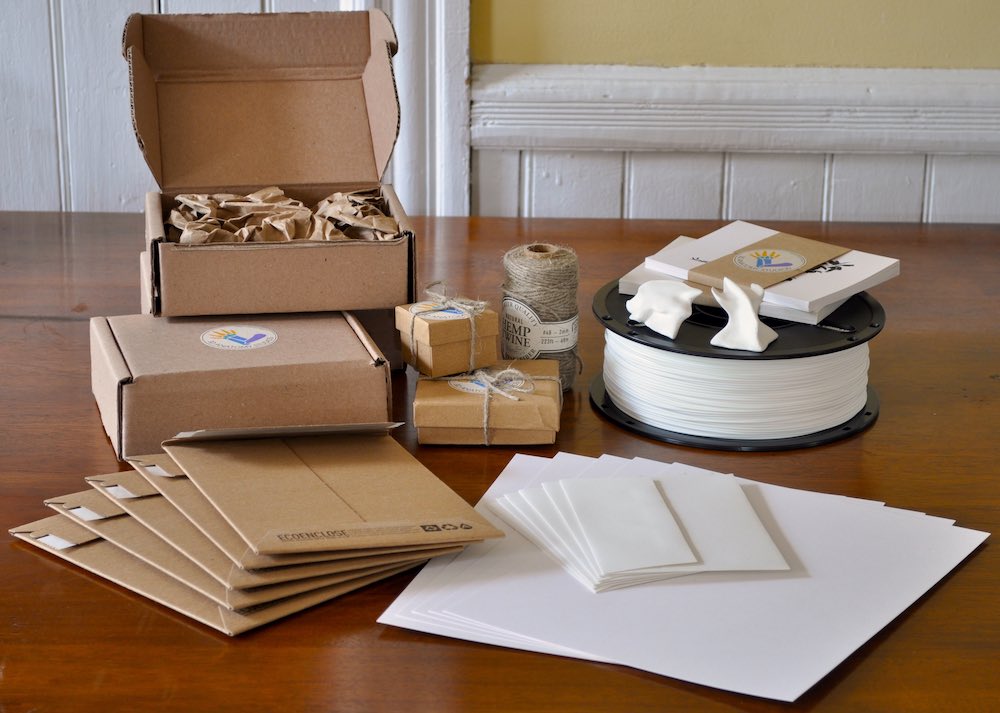Our commitment to sustainability
Environmental sustainability is one of our core values at 3D Anatomy Studios. As biologists, we are aware of all the ways in which humans have negatively impacted and continue to negatively impact the Earth. We are also deeply aware of how much humans depend on and benefit from healthy ecosystems. As a result, we feel an ethical duty to ensure our small business at the very least minimizes its negative impact on the environment. Particularly as a small business dedicated to advancing the understanding of Earth’s many fascinating organisms.
We’ve made deliberate and carefully considered decisions about how to operate our small business so that we reduce as much as possible our negative environmental impact. Whenever possible, we use recycled, recyclable, renewable, and compostable materials to create and ship our products. This means that sometimes our product packaging may include repurposed materials (e.g., padding cut from cardboard boxes) so that we can maximize the usage of these materials. Below we list the sustainability information for the most common materials we use.

Paper products
All of the paper products we use (with the exception of the compostable stickers made from sugarcane) are made from recycled content. This reduces the use of virgin wood fibers for paper production and increases the use of recycled materials.
Recycled copy paper
For printing invoices and other basic documents we use copy paper made from 100% post-consumer recycled fiber. This paper is curbside recyclable and biodegradable.
Recycled 80 lb. cover cardstock
For printing the collection cards that we ship with some of our 3D printed products and other applications where we need a medium thickness cardstock paper, we use 80 lb. cover cardstock made from 100% post-consumer recycled fiber. This paper is curbside recyclable and biodegradable. We currently source this material from Mohawk (via The Paper Mill Store).
Recycled 92 lb. cover cardstock
For our in-house designed and printed stationery and other applications where we need a thicker cardstock paper with a textured surface, we use a 92 lb. cover cardstock made from 100% post-consumer recycled fiber. This paper is curbside recyclable and biodegradable. We currently source this paper from Arjowiggins (via The Paper Mill Store).
Recycled tab-locking cardboard boxes
For shipping non-flat items, such as our 3D prints and stationery, we use tab-locking cardboard boxes made from 100% recycled content (95% post-consumer waste). These boxes are curbside recyclable and biodegradable. We currently source these boxes from EcoEnclose.
Recycled rigid and padded mailers
For shipping flat items such as our stickers or small volumes of stationery, we use padded or rigid mailers made from 100% recycled content (90% post-consumer waste). These mailers are curbside recyclable and biodegradable. We currently source these mailers from EcoEnclose.
Recycled biodegradable packing tape
When we use tape to close our boxes for shipping, we use water-activated tape made from 50% recycled content. While the recycled content is only 50%, this tape is made entirely from renewable materials. This tape is curbside recyclable and biodegradable. We currently source this tape from EcoEnclose.
Recycled envelopes
The A2 envelopes that we include with our in-house designed and manufactured stationery are made from 100% recycled fiber. These envelopes are curbside recyclable and biodegradable. We currently source these envelopes from Mohawk (via EcoEnclose).
Recycled wheat packing paper
To protect our products during shipping and to add a decorative kraft wrapped band to our in-house designed and manufactured stationery, we use NextGen wheat paper. This paper is made with 80% recycled content and 20% wheat straw (a waste product from agricultural wheat production). This paper is curbside recyclable and biodegradable. We currently source this paper from EcoEnclose.
Compostable paper stickers
To add custom branding to our packaging (the round stickers with our logo on some of our packaging), we use 100% compostable stickers made from unbleached sugarcane paper (tree-free). We currently source these stickers from Elevate Packaging.
Plastic products
Plastics are neither truly recyclable (despite the plastics industry’s attempts to convince the public otherwise) nor biodegradable. However, for certain applications we have not yet found a better alternative. Thus, we do our best to reduce our use of plastics, design products that will get multiple uses over a long life (i.e., as opposed to single use plastics), and choose plastics that have the lowest environmental impact.
PLA bioplastic 3D printing filament
For 3D printing we exclusively use filament extrusion printers (also known as FDM, or fused deposition modeling, printers) and PLA bioplastic filament. One reason we use PLA (versus other printer filaments such as ABS) is because it is made entirely from renewable plant materials (e.g., cornstarch, potato starch, sugarcane, and tapioca roots) rather than nonrenewable petroleum products. A second reason we use PLA is that it doesn’t emit toxic fumes during the printing process; a better choice for both the environment and for our own health!
Despite being made from plant materials, the manufacturing process makes PLA highly resistant to biodegradation. Thus, PLA is considered industrially compostable rather than biodegradable. This means that it can be composted only under special conditions not easily achieved in a garden compost pile (temperatures must be fairly high and decomposition is accelerated by the presence of particular enzymes). We hope one day to collect all of our waste PLA (e.g., supports, prototypes, misprints) so that we can compost it either through partnering with an industrial composter or developing our own in-house composting solution.
Despite the availability of other 3D printing methods, such as SLS and SLA 3D printing, we use filament extrusion exclusively. SLA 3D printing, the other 3D printing method most accessible to small businesses like us, uses a laser to cure a plastic resin rather than melting plastic. So far we have been unable to find a resin that matches PLA’s low environmental impact. Prior to the curing process, 3D printing resins are generally toxic. In addition, once the resin is cured it can neither be reused nor composted (even industrially). The few biodegradable resins that are available are either prohibitively expensive or not available in a wide enough selection of colors for us to use.
Clear vinyl stickers
Our in-house designed stickers (currently made by StickerYou) are made from durable, clear vinyl. Despite being made from nonrenewable petroleum, the quantity of material is relatively low and the durability of these stickers provides months of use and enjoyment (in contrast to single-use plastics).
Thin-film plastic wrap
To make packages water resistant for shipping, it is standard to use poly mailers (padded or unpadded), which are generally not recyclable and end up in landfills. Instead of poly mailers, we sometimes wrap our paper packaging in thin-film plastic to provide water resistance. This has two advantages over poly mailers. Firstly, this thin-film plastic can be recycled anywhere that plastic bags can be recycled (grocery stores generally have collection containers). Secondly, because thin-film plastic is thinner than the plastic used for poly mailers, it uses a fraction of the material. Even the lightest poly mailers (small and without any added padding), weigh 0.5 oz (14 g). We can wrap our small boxes with less than 0.15 oz (5 g) of thin-film plastic, using 65% less plastic than with a poly mailer.
Other materials
Hemp twine
To add handcrafted charm to our gift wrapping we use hemp twine. We loop the twine around each side of the gift box and tie it into a bow on the top. Hemp twine is 100% renewable and biodegradable.

